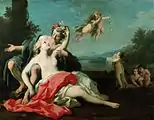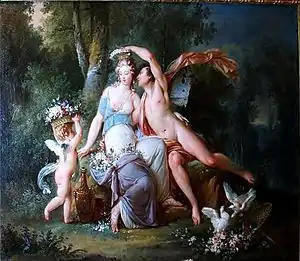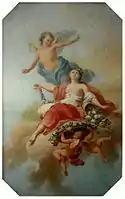Flore et Zéphire
Flore et Zéphire is a one-act ballet choreographed by Charles-Louis Didelot to music by Cesare Bossi, premiered in London at the King's Theatre, Haymarket on Thursday, 7 July 1796.[1] The ballet tells the story of Zephyr, the fickle west wind, and his wife Flora, a nymph of flowers and springtime. The ballet was originally composed in 1795 for performance in Lyon, France, and was revised in 1796 prior to its London premiere.[2] Flore et Zéphire used "flying machines" to send dancers soaring above the stage on nearly invisible wires, in order to enhance the presentation of Flora and Zephyr as spirits of the air. The ballet is credited with the introduction of dancing en pointe to the stage.[1]

Plot
The story of Flore et Zéphire is set on Mount Olympus in Greece, where Boreas, the north wind, plots to abduct Flora, the wife of Zephyr, the west wind. Introducing a game of blind man's bluff, Boreas separates the couple and kills Zephyr with an arrow. He then takes Flora to his cave, where she faints from fright. Nine muses in mourning bring Zephyr's body to Mount Olympus where, after his funeral procession, he comes back to life. The muses tie Flora securely to Zephyr's wrist so they will not be separated again and Boreas is punished.
Background
In 1795 Didelot created the ballet La Métamorphose for Lyon, and in 1796 he revised the work as Flore et Zéphire. The ballet premiered in London at the King's Theatre in 1796, ultimately ushering in a new and important—but brief—era in ballet subsequently known as the Pre-Romantic.[2]
Pre-Romanticism in ballet belonged largely to the Anacreontic genre, which emphasized light-hearted treatment of Classical subjects rather than the restrained formality of Classicism. Anacreontism had become popular at the end of the eighteenth century when the taste for Greek and Roman antiquarianism had run its course at the court of Louis XVI.[2] As a whole, Pre-Romantic ballet coincided with the birth of the Romantic movement in Europe at the end of the eighteenth century.
Production details
Flore et Zéphire starred Didelot as Zephyr, his wife Rose as Flora, and Hilligsberg as Cupid. At the London premiere, the stage machinery by the engineer Liparotti used counterweighted wires to balance, support, and fly individual dancers.[1][3] London audiences gasped as ballerinas balanced on demi-pointe (half toes) then took a few steps sur les pointes just before rising in the air and circling the stage for several minutes. Critics delivered dire warnings regarding the machines and ballerinas demanded higher wages for being sent into the air, but the delighted Diderot continued to experiment with the apparatus and sent flocks of ballerinas soaring aloft.[4]
The most significant artistic and historical contribution made to ballet by Flore et Zéphire, however, was dancing sur les pointes (on the toes). Speculation suggests this unusual feat was accomplished by the ballerina momentarily posing on the tip of her toe as the flying machine took her weight for suspended flight. Maria Danilova, Geneviève Gosselin and Fanny Bias all performed Flore and were noted for dancing sur les pointes.[5]
Subsequent history
Flore et Zéphire became Didelot's most enduring work and was revived in a variety of versions for fifty years.[1] In 1799, the ballet's success across Europe prompted the Russian court to extend an invitation to Didelot to become the director of the czar's several imperial theatres—an invitation Didelot accepted.
In 1808, he retitled the ballet Zéphire et Flore for a St. Petersburg production starring Louis Duport, a well-known French danseur.[2] In 1830, Marie Taglioni made her London debut as Flore[3] and in 1834 the ballet became a star vehicle for the ballerina and Jules Perrot.[1][note 1][6]
- Flore et Zéphire in art
 Zephyr Crowning Flora, Louis de Boullogne
Zephyr Crowning Flora, Louis de Boullogne Flora and Zephyr Jacopo Amigoni, 1700s
Flora and Zephyr Jacopo Amigoni, 1700s Zephyr Crowning Flora, Jean-Frédéric Schall
Zephyr Crowning Flora, Jean-Frédéric Schall Zephyr and Flora, Jan Bogumił Plersch, 1778
Zephyr and Flora, Jan Bogumił Plersch, 1778.jpg.webp) William-Adolphe Bouguereau, Flora and Zephyr, 1875
William-Adolphe Bouguereau, Flora and Zephyr, 1875
See also
References
| Wikimedia Commons has media related to Zephire et Flore. |
- Notes
- Taglioni would become the foremost ballerina associated with pointe work when she appeared in the middle 1830s in La Sylphide, a ballet choreographed by her father Filippo Taglioni specifically for her talents.
- Footnotes
- Kirstein 1984, pp. 130–131
- Greskovic 2005, pp. 28–30
- Craine 2002, p. 324
- Garfunkel 2002, pp. 24–25
- Lee 2002, p. 189
- Greskovic 2005, p. 30
- Bibliography
- Craine, Debra (2002), The Oxford Dictionary of Dance, Oxford and New York: Oxford University Press, ISBN 0-19-860400-9
- Garfunkel, Trudy (2002) [1994], On Wings of Joy, Ereads Ltd., ISBN 0-7592-2862-0
- Greskovic, Robert (2005) [1998], Ballet 101: A Complete Guide to Learning and Loving the Ballet, Pompton Plains and Milwaukee: Limelight Editions, ISBN 0-87910-325-6
- Kirstein, Lincoln (1984) [1970], Four Centuries of Ballet: Fifty Masterworks, Mineola: Dover Publications, ISBN 0-486-24631-0
- Lee, Carol (2002), Ballet in Western Culture, London and New York: Routledge, ISBN 0-415-94256-X